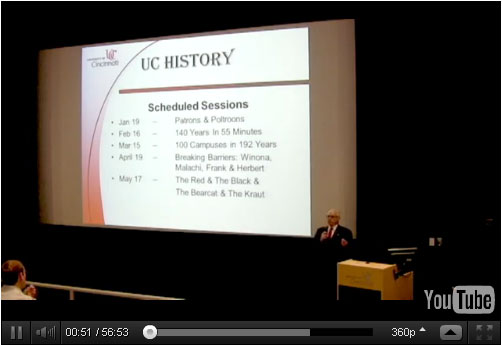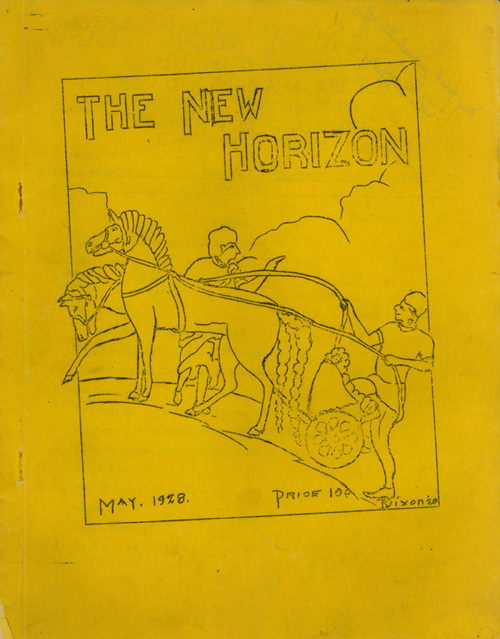If you have ever donated blood, you probably did not sit and think about the history of blood donation in the process. You likely were more concerned about the needle stick, watching that little bag fill up with your blood or avoiding doing so, or maybe you were already thinking about that cookie you could eat after it was all over. What you may not have realized was the important role the University of Cincinnati played in developing the modern blood donation process. Certainly, if you have ever donated blood in the Greater Cincinnati area, you have heard of the Hoxworth Blood Center, which is actually part of the University of Cincinnati. You may not have heard of its namesake, though. Dr. Paul Hoxworth was the founder of Greater Cincinnati’s blood bank. He helped to revolutionize blood donation, thereby saving countless lives. Continue reading
Tag Archives: uc history
Greg Hand's History of UC Series Now Available from the ARB Website
By Janice Schulz
In January, 2012, UC Assistant Vice President and University Spokesperson Greg Hand began a series of lunchtime talks focusing on the history of the University of Cincinnati. At the inaugural presentation, Hand noted that the dozen or so talks he plans to give will be a good way to get people thinking about the University’s bicentennial celebration in 2019. The UC Foundation has agreed to record and post each lecture and make them available on the web. The first two, “Cincinnati’s Efforts to Create a University: 1800 to 1870” and “An Overview of UC History from 1870 to 2010” have been posted and are linked from ARB’s University Archives page.
The talks are held the third Thursday of each month at 12:30 p.m. in TUC’s Main Street Cinema. The remainder of Hand’s talks this academic year includes:
- March 15 — Evolution of UC’s Campus and Many Campuses of UC’s Colleges
- April 19 — Student Pioneers: First Alumni
- May 17 — Origin of UC Regalia & Symbols
The University Archives page offers many links to information about UC’s history and is a great starting point for researchers interested in UC’s story.
City Reports Offer Wealth of Information for Cincinnati Researchers

In 1912 the Department of Charities and Correction launched a crusade against loan sharks who were targeting the poor of Cincinnati
By Janice Schulz
The Archives & Rare Books Library holds City of Cincinnati Annual Reports from 1853-1870, 1875-1876, 1905-1914, and 1926-1958. These reports contain valuable information for anyone researching the history of Cincinnati, its departments, its people, and its issues.
While reports included in each volume vary, the Mayor’s report is always available. Also available may be various city financial reports and reports from City Council, schools, the Health Department and health care facilities, the House of Refuge, the Fire Department, the Police Department, Public Works, the City Engineer, jails, Civil Service Commission, City Solicitor, Parks Department, the University of Cincinnati, and other city commissions. Until 1914, each individual annual report is published in full, but after that time the reports take on more of a summarized format under the title Municipal Activities. Continue reading
Does the Magic 8 Ball have a UC connection? Signs Point to Yes.
By Janice Schulz
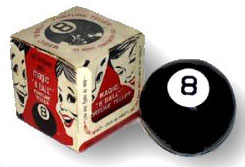 At the Archives & Rare Books Library we frequently get requests asking us to verify that a certain individual attended UC or one of its predecessor schools. Recently a call came in asking us to substantiate a claim found on the internet that Abe Bookman, creator of the Magic 8 Ball, was a graduate of the Ohio Mechanics Institute (OMI). Generally this is an easy task – we simply look in alumni directories, yearbooks or commencement brochures for the person – but Abe proved to be a bit more elusive than most. With no attendance dates to go by, we started pouring through all of the resources we have for OMI using his birth date and the Magic 8 Ball’s introduction as guides, but to no avail. After further research, the reason for his elusiveness began to become clearer – at some point around 1936, we believe he Anglicized his surname from Buchmann to Bookman. He seemed to use both names until around 1955, eventually dropping Buchmann and exclusively using Bookman. That research also uncovered some interesting details about his life. Continue reading
At the Archives & Rare Books Library we frequently get requests asking us to verify that a certain individual attended UC or one of its predecessor schools. Recently a call came in asking us to substantiate a claim found on the internet that Abe Bookman, creator of the Magic 8 Ball, was a graduate of the Ohio Mechanics Institute (OMI). Generally this is an easy task – we simply look in alumni directories, yearbooks or commencement brochures for the person – but Abe proved to be a bit more elusive than most. With no attendance dates to go by, we started pouring through all of the resources we have for OMI using his birth date and the Magic 8 Ball’s introduction as guides, but to no avail. After further research, the reason for his elusiveness began to become clearer – at some point around 1936, we believe he Anglicized his surname from Buchmann to Bookman. He seemed to use both names until around 1955, eventually dropping Buchmann and exclusively using Bookman. That research also uncovered some interesting details about his life. Continue reading
The Estimable Mr. Hoffner
By Kevin Grace
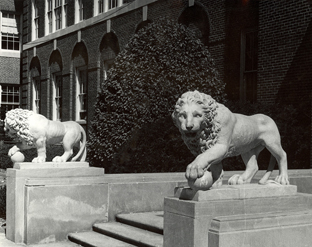
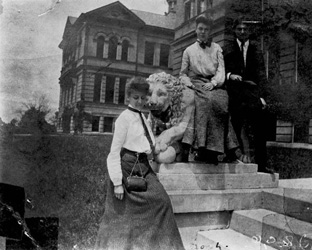 The University of Cincinnati community is well-schooled in the story of its lions, Mick and Mack, perhaps ad nauseam. Here in the Archives & Rare Books Library, the subject is a frequent one: we relate to the inquirer how they stand as sentinels in front of McMicken Hall, once facing each other but now facing away (Mick is on the left, Mack on the right), how occasionally lipstick marks will be found on them, and that they supposedly roar whenever a virgin walks by. The fact that they have never roared should not trouble the demure – non-roaring lions are a hoary tale on many campuses. And, that Mick and Mack took up their posts in 1904 when UC was a municipal university and city officials needed to find an appropriate home for them. And, that the lions are copies of larger versions in the Loggia dei Lanzi in Florence, Italy (not Kentucky). And, that even one of those “originals” was a copy of ancient Roman statue.
The University of Cincinnati community is well-schooled in the story of its lions, Mick and Mack, perhaps ad nauseam. Here in the Archives & Rare Books Library, the subject is a frequent one: we relate to the inquirer how they stand as sentinels in front of McMicken Hall, once facing each other but now facing away (Mick is on the left, Mack on the right), how occasionally lipstick marks will be found on them, and that they supposedly roar whenever a virgin walks by. The fact that they have never roared should not trouble the demure – non-roaring lions are a hoary tale on many campuses. And, that Mick and Mack took up their posts in 1904 when UC was a municipal university and city officials needed to find an appropriate home for them. And, that the lions are copies of larger versions in the Loggia dei Lanzi in Florence, Italy (not Kentucky). And, that even one of those “originals” was a copy of ancient Roman statue.
But what of the lions’ owner and the university’s benefactor, Jacob Hoffner? Who the heck was he and what was he doing with marble lions? We’ve always known a bit about him, that he was a Cincinnati real estate man and business speculator who enjoyed traveling in Europe. He maintained a nice little estate in Northside and decorated his gardens with a variety of statuary, some of which he had copied from what he saw abroad. Hence, the lions. Hoffner died in 1894 at the age of 96, leaving everything for the use of his wife, Maria. On her death in 1904, following a part of Jacob’s will, his statuary was donated to the city. And that was that. Continue reading
Twenty-Fifth General Hospital: Courage and Skill in World War II
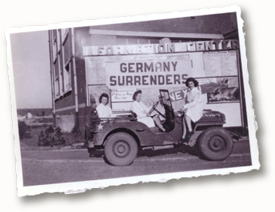 A new web exhibit from UC Libraries’ Henry R. Winkler Center for the History of the Health Professions commemorates the service of the 25th General Hospital in World War II.
A new web exhibit from UC Libraries’ Henry R. Winkler Center for the History of the Health Professions commemorates the service of the 25th General Hospital in World War II.
Our Bearcat Image Library is Growing Again!
By Janice Schulz
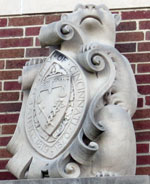 Two new images have been added to our Bearcat exhibit. The photographs, taken by ARB Student Assistant Lauren Fink, depict the Bearcat making a stand around campus. The first is one of two statues guarding the Clifton Avenue entrance to McMicken Hall. Just find Mick and Mack and look up to see these fellows dutifully scanning the horizon. The second is a large inflatable bearcat currently holding ground in the UC Bookstore. He stands confidently and proudly welcoming customers to the Bookstore’s upper level.
Two new images have been added to our Bearcat exhibit. The photographs, taken by ARB Student Assistant Lauren Fink, depict the Bearcat making a stand around campus. The first is one of two statues guarding the Clifton Avenue entrance to McMicken Hall. Just find Mick and Mack and look up to see these fellows dutifully scanning the horizon. The second is a large inflatable bearcat currently holding ground in the UC Bookstore. He stands confidently and proudly welcoming customers to the Bookstore’s upper level.
Ohio Archives Month: Buckeyes in the Civil War
By Kevin Grace
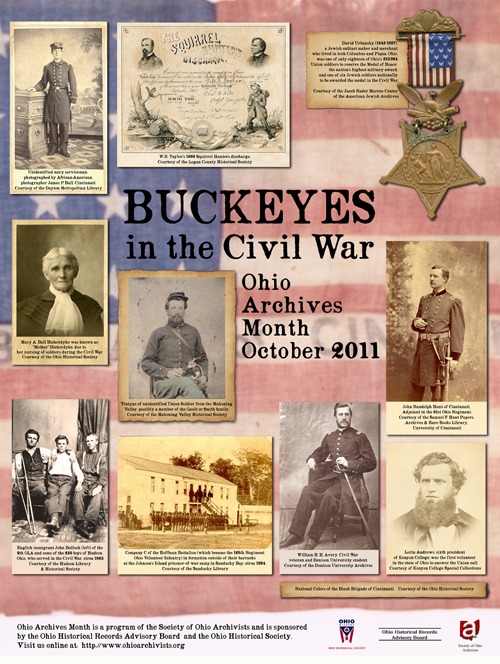 Every year, October is designated as Ohio Archives Month, and for 2011 the theme is “Buckeyes in the Civil War.” The Archives & Rare Books Library joined several other Ohio repositories in contributing an image to this year’s poster. Our image is of Cincinnatian John R. Hunt, who served as an Adjutant in the war. His brother, Samuel T. Hunt, was a Cincinnati jurist who helped form the University of Cincinnati in 1870 and served as one of the early board members.
Every year, October is designated as Ohio Archives Month, and for 2011 the theme is “Buckeyes in the Civil War.” The Archives & Rare Books Library joined several other Ohio repositories in contributing an image to this year’s poster. Our image is of Cincinnatian John R. Hunt, who served as an Adjutant in the war. His brother, Samuel T. Hunt, was a Cincinnati jurist who helped form the University of Cincinnati in 1870 and served as one of the early board members.
For more information on the 150th anniversary of the Civil War in Ohio and across the nation, please go to ARB’s website and its special Civil War commemorative page: http://www.libraries.uc.edu/libraries/arb/exhibits/civil-war/index.html. On that page, we have linked to our full-text digitized issue of the 1863 Colored Citizen, one of the few issues in existence, as well as links to Civil War books, images, and letters. For further information on the Archives & Rare Books Library and its holdings, please call 513.556.1959, email archives@ucmail.uc.edu, or visit the website at http://www.libraries.uc.edu/libraries/arb/index.html.
T. M. Berry Project: The New Horizon
By Laura Laugle
Now that the physical processing of the Berry collection is complete and I’ve begun arranging materials, I’ve come across some items which, when I processed them months and months ago, I was too ignorant of their context to fully appreciate. Chief among those items are three copies of The New Horizon. I had no idea when I pulled out the rusty staples, pried off the bits of rapidly disintegrating paperclips and filed them temporarily (read: labeled with a removable sticky note) as “Misc. Copies of New Horizon” how incredibly important these school papers really are. Continue reading
College of Music Historical Collection in ARB
By Lauren Fink
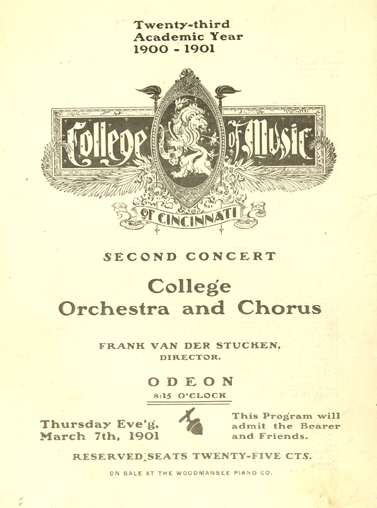 In the Archives and Rare Books Library, we recently processed a collection containing historical records of the College of Music of Cincinnati. This collection spans 1878-1967 and contains commencement bulletins, programs, student rosters, and minutes of executive, financial, and stockholder’s committee meetings. Illustrating the historical and biographical nature of this collection, the 1926 commencement bulletin entitled “College Comments,” contains articles on the College’s faculty, graduating students, clubs, and ensembles. Further, meeting minutes provide details of all of the College’s major educational and financial concerns and
In the Archives and Rare Books Library, we recently processed a collection containing historical records of the College of Music of Cincinnati. This collection spans 1878-1967 and contains commencement bulletins, programs, student rosters, and minutes of executive, financial, and stockholder’s committee meetings. Illustrating the historical and biographical nature of this collection, the 1926 commencement bulletin entitled “College Comments,” contains articles on the College’s faculty, graduating students, clubs, and ensembles. Further, meeting minutes provide details of all of the College’s major educational and financial concerns and 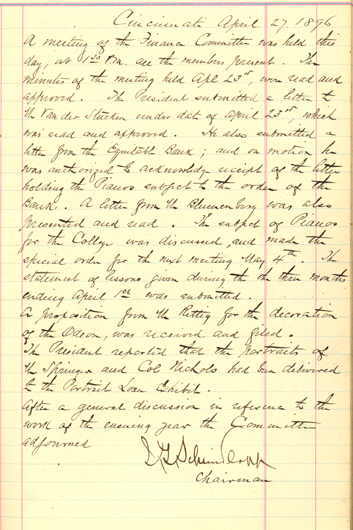 decisions, such as how to create more space for radio labs or the necessity of hiring certain faculty for certain departments. The minutes also contain outlines of correspondence between the College and the Conservatory of Music on having a connection with each other. To view the contents of this new collection, see the finding aid online (http://rave.ohiolink.edu/archives/ead/OhCiUAR0287). Continue reading
decisions, such as how to create more space for radio labs or the necessity of hiring certain faculty for certain departments. The minutes also contain outlines of correspondence between the College and the Conservatory of Music on having a connection with each other. To view the contents of this new collection, see the finding aid online (http://rave.ohiolink.edu/archives/ead/OhCiUAR0287). Continue reading


